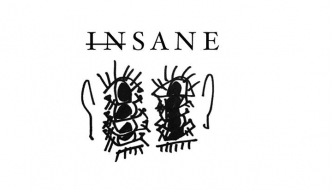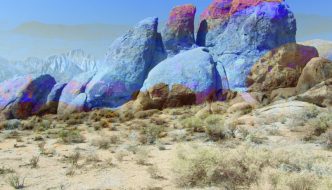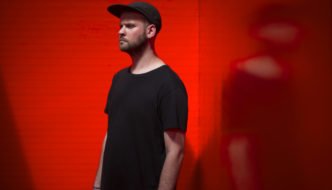Joss Cole is a painter who founded Cole’s Gallery in 2019 in the Kirkgate Markets in Leeds before moving to a larger retail unit in the Leeds Corn Exchange two years later. The gallery space serves as both a galley and a studio space. Joss’ work is often expressive and energetic, with a focus on literature, and seeks to capture those big eureka moments where creative inspiration clicks into place.
Court Spencer went to Cole‘s Gallery to catch up with him.

Joss in front of his work for the Neville Street Commission.
Court: Hey Joss. Thank you so much for your time today. As we’re here in the galley, I suppose it makes sense to start with that. You started Cole’s Gallery in the markets before moving over here. What year did you open, when did you move over here, and what was the motivation behind starting a gallery?
Joss: Hi Court, thank you for coming to visit. I started the gallery at the beginning of 2019 in Leeds Kirkgate Market, just in time to get a little organized before we were closed for COVID. The Gallery was able to re-open back and forth and get a good feel for showing all types of artists and work on a modest scale in the market. The beautiful buildings, historic surroundings, and random people made for great inspiration in my own work and an inspiring backdrop for the Gallery.
At the end of 2021, with reduced rents and encouragement from supporters and other artists, I decided to move across the road to Leeds Corn Exchange. This gave us a lot more space to show bigger works and have evening events on Thursdays.
My main motivation for opening the Gallery was to enable artists to have a professional yet freewheeling, consistent outlet to show their work. It’s relatively easy for singers, bands, or guys with guitars to get their songs out to an audience at pubs or venues. I wanted to create a hub like that for art.
Court: You’re so right! And that’s a great comparison. So, how do you go about finding artists to show? Do you find them, do they approach you, do you promote open callouts, or is it all of the above?
Joss: Good question. Yes, it’s all of the above. We have shown art from very established artists, RA and RCA graduates through to the hobbyist non-conformist artists. We do this through open calls, submissions, friendly artist relationships I have built up over the years, recommendations, and working with art groups and organisations. All good galleries should have communities around them. If you work to be part of the circle, it’s a good way to help your practice, connect with like-minded people and increase your options for showing.

Cole’s Gallery.
Court: Is there anything that you have found surprising about having a gallery? And what would you say you enjoy most about having the gallery?
Joss: I think the most surprising thing is all the goodwill and encouragement from artists, visitors, and buyers. People really want to be part of art communities and exhibitions. Why couldn’t every workplace have an art gallery? People have a deep desire to exhibit, see art, and share experiences. I think often as artists we get consumed with the creation of the work, but there are many parts to showing art and exhibiting it. Sending it out into the world can be a way of completing it.
Another great part of running the Gallery is the wonderful collaborations that naturally occur. I am working on a new themed night based on Nostalgia and Leeds ephemera called ‘Slideshow’, with artist and tour guide Biroguy (Clifford Stead). Watch this space!
Court: I look forward to hearing more about that! Moving onto your own practice. How did you come to art? Was it something you were encouraged to pursue?
Joss: Yes, my parents were very encouraging; my dad and I learned watercolour painting together, and he taught me too. With my mom, we discuss books, ideas, and random things, which is a great inspiration. I first loved drawing and painting because, as a child, I loved dinosaurs. The fact that the only way we can really know what dinosaurs look like is through imaginary visual representations is an exciting one to me. That is the kind of wider way I look at making my paintings now, even without dinosaurs.

Details of Flying Cat and Red Kite Epiphanies, 2024, Joss Cole, watercolour on paper.
Court: So, in some respects, your work really pulls from your parents with watercolour and literature. Literature, and particularly poetry, feels like a focus within your work. Can you say a little about that?
Joss: The works’ aim is to be associated with poetry but not to follow the often cringe-worthy pairing of the adjectives ‘poetic’, and painting. I think that poetry is the closest written discourse to painting, and I find visual lyrical poetry like Arthur Rimbaud, Walt Whitman and Denise Levertov analogous and inspiring to my paintings. I have talked about this in my artist statements in the past. I like the idea of being a ‘posey painter’, which is a pun on the acknowledgement that paintings are often about attracting attention, and many an artist is a ‘poseur’, contrasted with the much more subtle, high-minded definition of poetry.
po·e·sy
n. pl. po·e·sies
2. The art or practice of composing poems. 3.The inspiration involved in composing poetry
Court: Are there any other influences that make their way into your work?
Joss: The writer and poet Roberto Bolano is a big inspiration. I also find sciences, sports, politics, psychology, and anything else that a painting could be made from or might be difficult to make. I love the idea of making representative work about abstract concepts. As William Blake said: “It’s all about trying to find the contraries”.
Court: I suppose the act of painting allows you to process an idea which then offers the viewer an alternative perspective to contemplate. You did your undergrad at Loughborough and then, a few years later, an MA at Wimbledon. What was your university experience like?
Joss: Art school is a brilliant time in most artists’ lives because of the space, opportunity, and like-minded people. It was these connections with other students and artists that were the most worthwhile element for me and encouraged me to set up a space. I hope more art courses encourage students to set up their own shows and events as well as develop a personal practice. Both Loughborough and Wimbledon were traditional art colleges that have been subsumed into the university model. This comes with some great advantages for research and funding, but a lack of individual personality and social and cultural life.

Details of Poets Garden, 2019, Joss Cole, watercolour on paper.
Court: When you finished your MA, you won an award that gave you a year at Acme Studios. Can you tell us a bit about that and the impact of that year?
Joss: I was incredibly fortunate to win the Chadwell Award. It was set up by Andrew Post and Mary Aylmer in 2010 in memory of Andrew’s mother.
The Chadwell Award provides a bridge between art school and practice as a professional artist by giving a recent Fine Art MA graduate a free studio. At the time, the award was in association with Acme Studios. The award was an incredible opportunity to expand my practice and exhibit my work. The opportunity gave me confidence and experience as a professional artist, which means I am a part of a prestigious list of alumni.
Court: That’s brilliant! I know you now work here in the Gallery and also at home. Do you have a set way of working? How do you approach a painting?
Joss: I have a few different strands to how I make my work. I make paintings out in the field, in situ on my French easel, responding to the subject of good or bad weather and light. I also make paintings that are more concept-led in the studio at home or in the Gallery. The paintings still reference open-air painting. I like to make all the paintings with the restless expressive energy that comes with painting fast out of doors.
I like to paint wet on wet, fluid transparent paint, so everything is moving or drying, and you have to work fast to keep everything in order, like conducting an orchestra.
Since setting up the Gallery I have formed a collaboration with the amazing Wallace Seymour Art Materials. Their paint and materials are made from long forgotten colours, alongside ancient and modern pigments. The paint is a natural extension of the subject matter, and the meaning of the paint is very inspirational. Many of the natural paints are made from pigments available in the Lake District. Honister Green Earth, Kendal Green, Malachite, Leighton Red Ochre (Native Earth), Leighton Red Ochre (Native Mineral), Eden Sandstone, and Delvers White.
Court: As an artist and a gallerist, you have a unique insight into the art world. Do you think this has changed the way you see your own practice?
Joss: I think this dual perspective has made me more aware of the audience for the work and when to embrace it and when to ignore it. I always try to contextualise the work I make while also making it for joy or for its own sake.
Court: That’s a really nice approach. Do you have any advice you would share with artists who are just beginning their journey?
Joss: My advice is to keep your own secret personal practice, but at the same time, form as many connections and groups to help support your art work as you can. These are people who can give you advice, critique, and help exhibit your work.
You don’t need many people to get an art career going, maybe five or six collectors, one or two dealers, one or two critics, and a couple of curators. So if you can build a network of twelve great people, you have something. This is great advice from the art critic Jerry Saltz.

Cole’s Gallery.
Court: What are some of your career highlights to date?
Joss: I have had a few different highlights, including the privilege of being able to set up the Gallery here in Leeds, the Chadwell Award, group shows with The Royal Watercolour Society, the New Light Art Prize, and the Neville Street Art Gallery public art commission for Leeds 2023 through Leeds Council. This project can be viewed on Neville Street in Leeds and online. [which you can view here!]
Court: Do you have a dream project or something you would love to make happen?
Joss: I would love to make a large retrospective exhibition of great watercolour painters of the past and an expanded view of contemporary work in the medium and its future. This would be linked to some adventurous painting trips, residences, and workshops in situ, promoting, teaching, and informing the exhibition.
Court: And what are you working on at the moment? Have you got any exhibitions of your own work coming up?
Joss: I am currently working on a group of paintings inspired by the atmosphere of live music. These works will be on display at Cole’s Gallery from 8 February – 4 March, with an evening opening on Thursday 15 Feb, 6–9 pm. All are welcome.
I will also be showing a new painting at the Royal Watercolour Society Open Exhibition, Bankside Gallery, London, 8-25 March.
Court: I look forward to seething those. And what’s the best way for people to keep in touch and see what you’re working on?
Joss: My Instagram pages that are @coles_gallery and @josscole23, and our website, www.colesgallery.co.uk.
Court: Brill! Thank you so much for your time and insight. It really has been a joy to spend the morning with you in the gallery. Thank you.
Filed under: Art
Tagged with: art, art practice, art school, artist, award, Cole's Gallery, community, creativity, exhibition, Galleries, gallery, leeds, painting, watercolour



Comments